Peppery, pungent and deeply nutritious, Punjabi Sarson ka Saag (or Sarson da Saag) is a favorite during the cold North Indian winters, especially when paired with Makki Ki Roti. Making this authentic dish is not hard, but it does take some time. Once you taste how vibrantly creamy and delicious it is, you won’t mind the work!
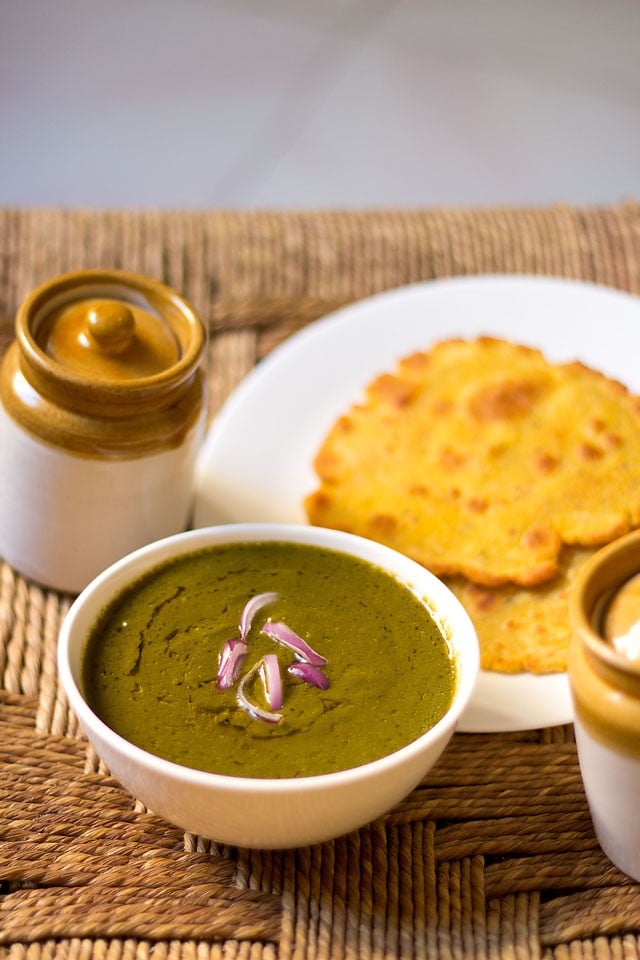
Table of Contents
About Sarson Ka Saag
Sarson is the Hindi/Punjabi word for mustard and saag means greens; thus, this recipe is for the traditional Indian preparation of mustard greens. Other versions of saag include: Palak Saag (spinach greens), bathua saag, or Chane ka Saag (chickpea greens).
Sarson ka saag is a type of curry, so it is creamy, saucy and simply addictive. Traditionally, it is served with an unleavened corn-based flatbread known as Makki di Roti, though it can also be served with Paratha and steamed basmati rice.
This sarson ka saag recipe is a labor of love, requiring both time and patience. Unfortunately, there is no shortcut method for making this dish.
You’ll need to sort the greens, then wash, chop, and cook them before blending them, after which you’ll need to cook them again. It is a labor-intensive process, but none of the steps are difficult.
While I’m aware that everyone wants their curry in a hurry nowadays, if you really want to savor the taste of an authentic sarson da saag then you’ll have to invest some time in preparing it.
The sarson ka saag recipe is very easy, but does take a lot of time to make; as such I like to break up the steps over the course of a few days.
Usually, I clean the greens one day before and keep them in the fridge in airtight containers so half of the work is over. Making the saag the following day makes it feel much easier.
At home, we generally use 5 different leafy green vegetables to make the saag. They are:
- Mustard Greens (sarson)
- Chenopodium/ Goosefoot leaves (called bathua in Hindi)
- Spinach (palak)
- White Radish Root and Greens (mooli)
- Fenugreek (methi)
You can see all the greens (with the exception of methi) in the photo below.
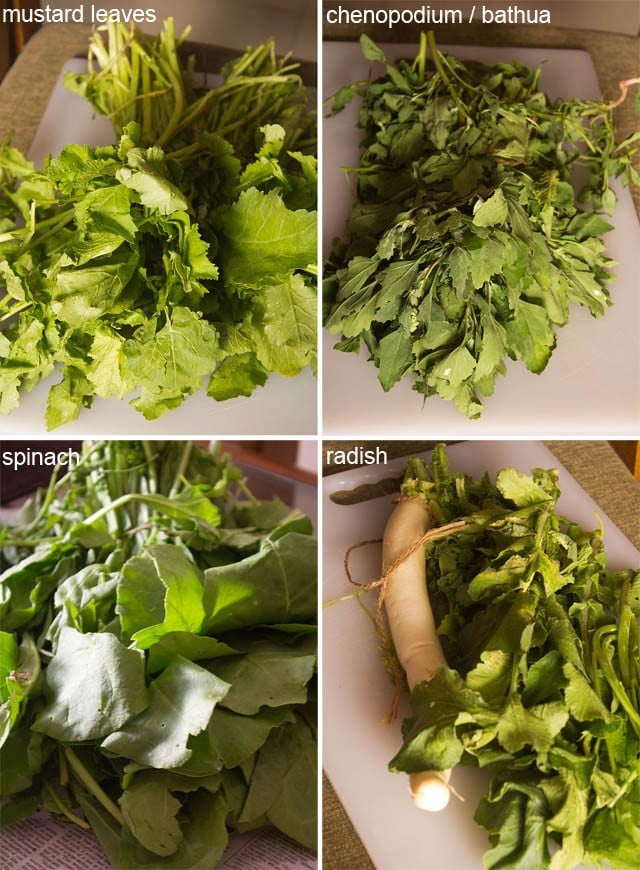
The predominant flavor in this saag recipe comes from the spicy, bitter mustard greens. The presence of spinach, bathua, and radish helps to lessen the bitterness of the mustard and methi so you end up with a creamy, mellow saag that is simply bursting with flavor.
Winter is the season for both mustard and bathua here in India. Sarson ka saag is therefore considered a cold-weather dish in North India, especially in Punjab from where this traditional recipe comes from.
The sarson da saag is usually topped with Homemade Butter and served with makki ki roti (flat breads from maize flour); this meal is not only comforting but also serves to warm up the palate and body.
With all of the dark, leafy greens, sarson ka saag is a bowlful of antioxidants and phytonutrients, so that extra topping of butter is alright.
The saag is also usually served with an accompaniment of sliced or chopped onions and some green chilies for some extra piquancy.
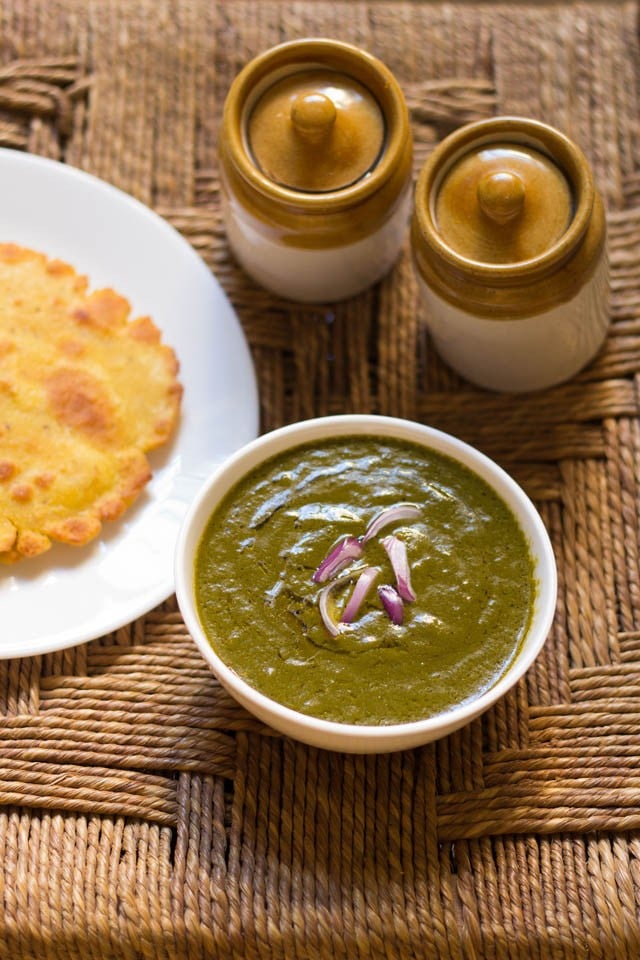
Because this is a time-intensive recipe, I always make sarson ka saag in bulk and keep it in the fridge. Then, when I need to serve it, all I have to do is temper the saag and then enjoy!
From what I have observed, the taste of the saag improves after about a day; all of the flavors meld as it ages. Mine usually does not last for more than 4 to 5 days, after which you can freeze any leftovers.
Saag Proportions
The recipe I present here is the traditional way we make saag at home. The proportion of bathua to spinach and mustard is 1:1:2. So for example, if you are using 1 whole bunch of mustard leaves then use a ½ bunch of bathua and a ½ bunch of spinach.
You can also consider using this ratio in cup measurement. Example for 2 cups of mustard greens use one cup each of spinach and bathua. Note that you can easily increase or decrease this ratio proportionately.
The other two greens – radish and fenugreek – are added using the Indian method of andaaz, which means we just eyeball it. Fenugreek is optional, though I love the flavor and health benefits it brings to this cozy winter meal.
This sarson ka saag recipe makes roughly 8 to 9 servings, but it can be easily halved or doubled.
How to make Sarson ka Saag
Prep, chop and clean all the greens
1: Remove the lower end of the mustard seems just a few centimeters from the base. The mustard stems can be tough, so it is up to you whether you want to discard the stems or keep them. If you keep them, then they have to be cooked really well so that they become soft.
Sort and prep the remaining greens as well – spinach, bathua, fenugreek leaves. For the radish, sort the leaves and peel, chop the root.
If prepping ahead a day earlier, refrigerate the greens and the radish root in ziplock bags or air-tight containers for a day.
You will need the following leafy greens:
- 1 bunch of mustard greens – cleaned & sorted
- ½ bunch of bathua or a small bunch
- ½ bunch of spinach or a small to medium-sized bunch
- 1 cup chopped tender radish greens
- 1 cup fenugreek leaves – optional
- 3 to 4 inches white radish root
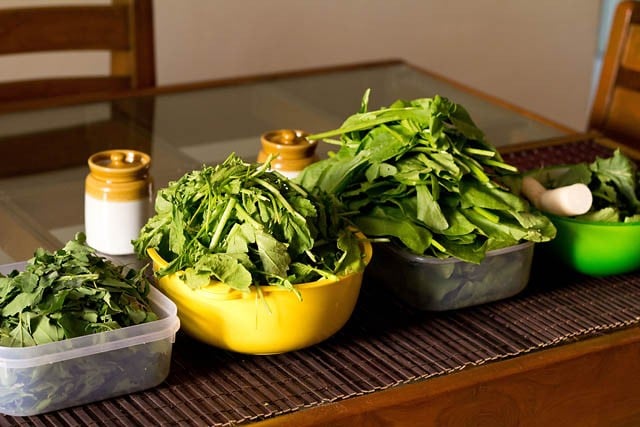
Rinse Greens
2: This is perhaps the most time-intensive part of the process. You have to really wash the greens – especially the mustard greens – to get rid of the mud clinging to the stems. Depending on the size of your sink, you may need to do this task in batches.
Note that the prep up to this point can be done up to 1 to 2 days in advance; keep the prepped greens in the fridge until you are ready to rinse the greens and then make the saag. Do not rinse the greens and store them in the fridge – they will rot.
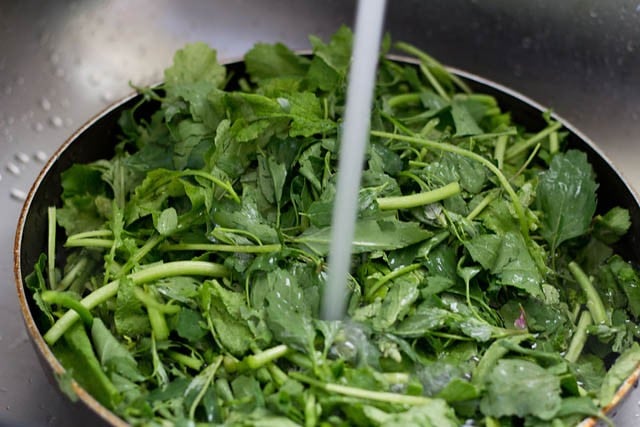
Pressure Cook
3: Add the greens to a 5 or 6 litre stove-top pressure cooker.
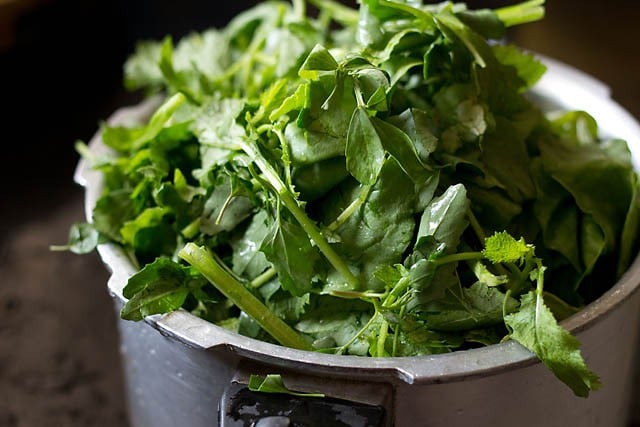
4: Add the other veggies – peeled and chopped radish root (2 to 3 inches), 1 cup chopped onions, 1.5 cups chopped tomatoes, 2 inches ginger (chopped) and 7 to 8 medium-sized garlic (chopped).
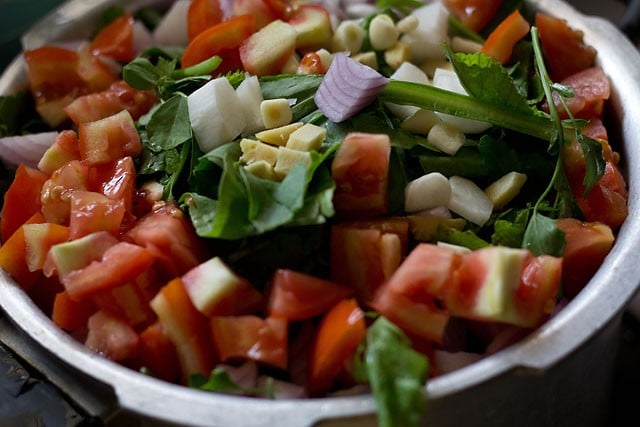
5: Season the greens using 2 green chilies (chopped), ½ teaspoon red chili powder, 2 to 3 pinches asafoetida (hing) & salt as needed.
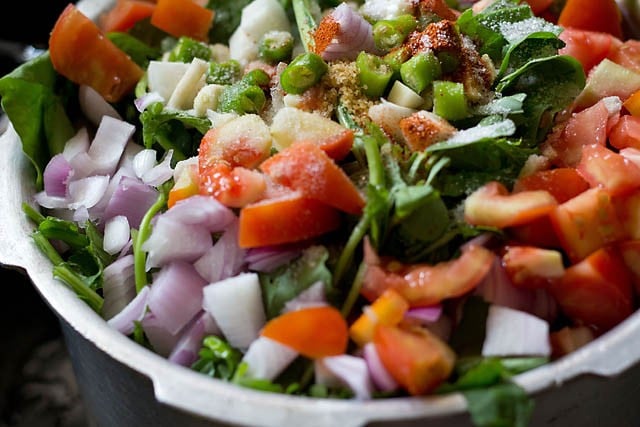
6: Add 2 to 3 cups water.
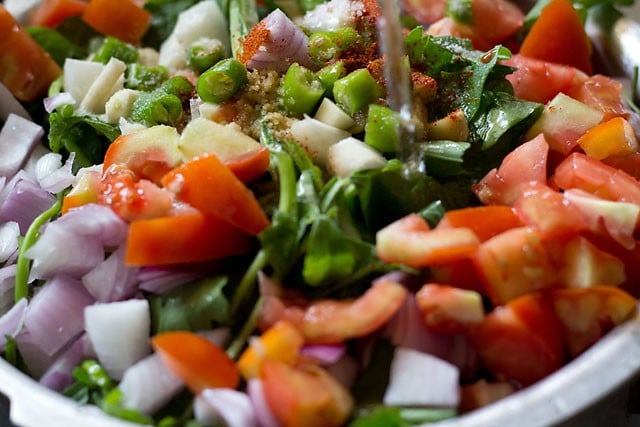
7: Cover and pressure cook for 6 to 7 minutes on medium-high heat, or until the greens become soft. Wait for the pressure to fall naturally in the cooker and then only open the lid.
You can also cook in a pan, though it will take longer. Cover and let the greens cook till they become soft.
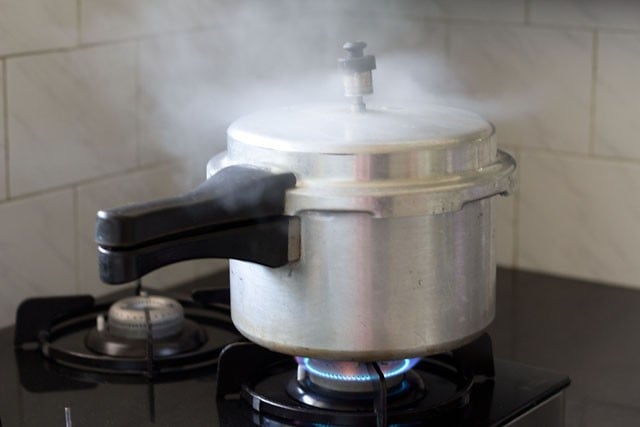
8: Let the pressure settle naturally in the cooker. When you open the lid, you will see the greens, onions, tomatoes etc all have cooked well. Let the greens mixture cool to room temperature.
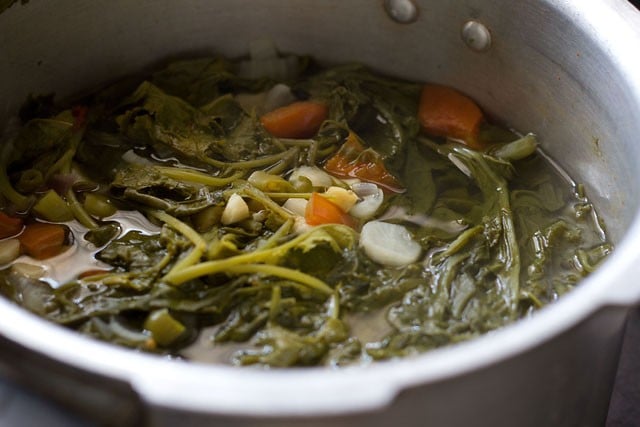
Blend The Greens
9: Add some of the greens and their cooking liquid to the base of a blender.
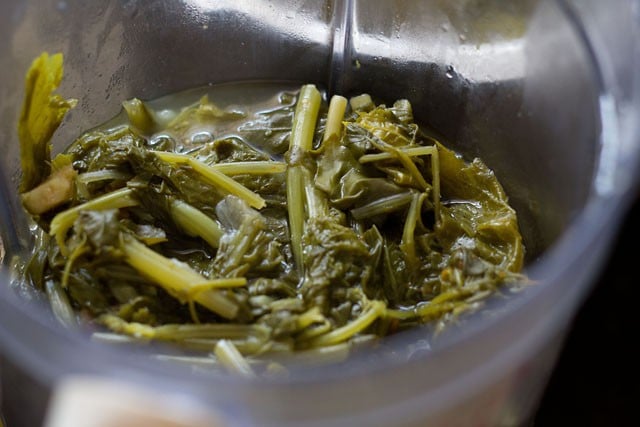
10: Add 2 tablespoons of maize flour (fine cornmeal).
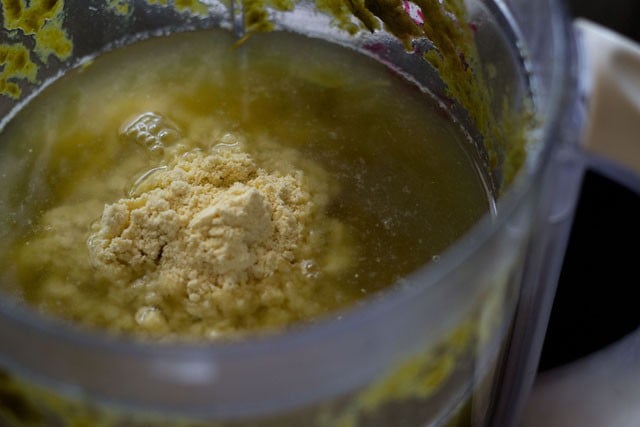
11: Working in batches, blend to your preferred consistency. I usually make a smooth puree, but some folks like a coarser texture.
You can also use a hand blender to minimize the number of dishes. If doing so, then chop the greens before you pressure cook them to make them easier to blend. The traditional way is to use a Madani (Indian hand blender) to blend the greens.
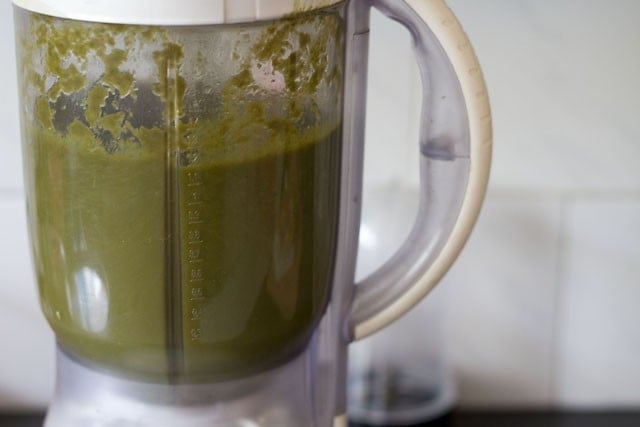
Cook The Pureed Sarson ka Saag
12: Pour the greens purée in a deep-sided pot, as it will bubble and splutter. You can also add it to the same cooker.
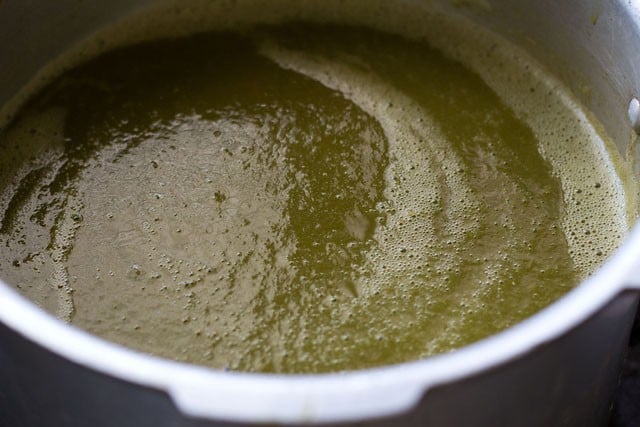
13: Simmer for a good 25 to 30 minutes. Stir occasionally so that the sarson da saag does not stick to the bottom of the pan. Check the seasonings and add more salt if required.
Once cooled, the saag can be kept in an airtight container in the fridge for 4 to 5 days.
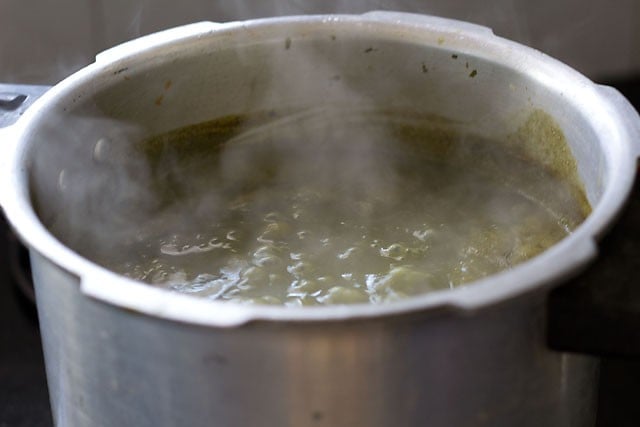
Make Tempering
14: The saag is not ready to be served yet – we still have to temper it. We always temper the saag with onions, but you can also add some ginger, green chilies and tomatoes along with the onions. Heat oil or ghee and add aromatics.
The amount of oil/ghee and onions to be added depends on the portions of saag you will be serving. For 3 servings, 1 to 2 tablespoons of oil with 1 medium-sized onion (about one-third cup finely chopped onions) is about right.
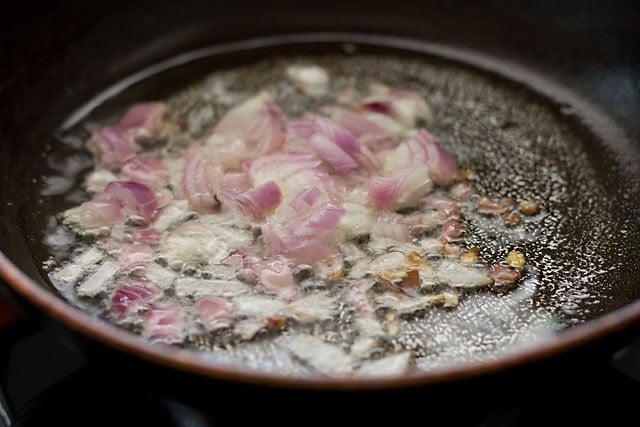
15: Lightly brown the onions.
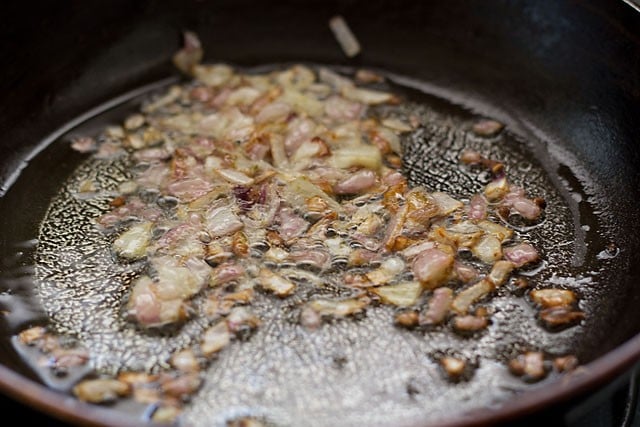
16: Add about 2 cups of the cooked sarson ka saag to the tempering. Simmer for a few minutes until the saag becomes hot.
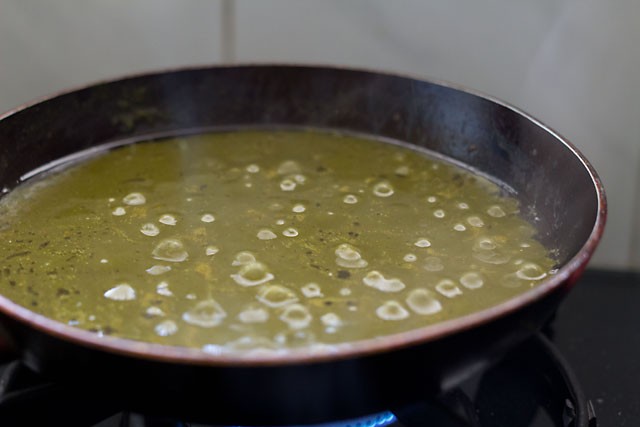
17: Serve the hot sarson ka saag straight away, preferably with makki di roti and a few jaggery cubes by the side – nothing beats this combination. You can also serve sarson da saag with paratha and steamed rice.
Pair this meal combination of the saag and makki ki roti with a side of freshly chopped onions and green chilies if you like.
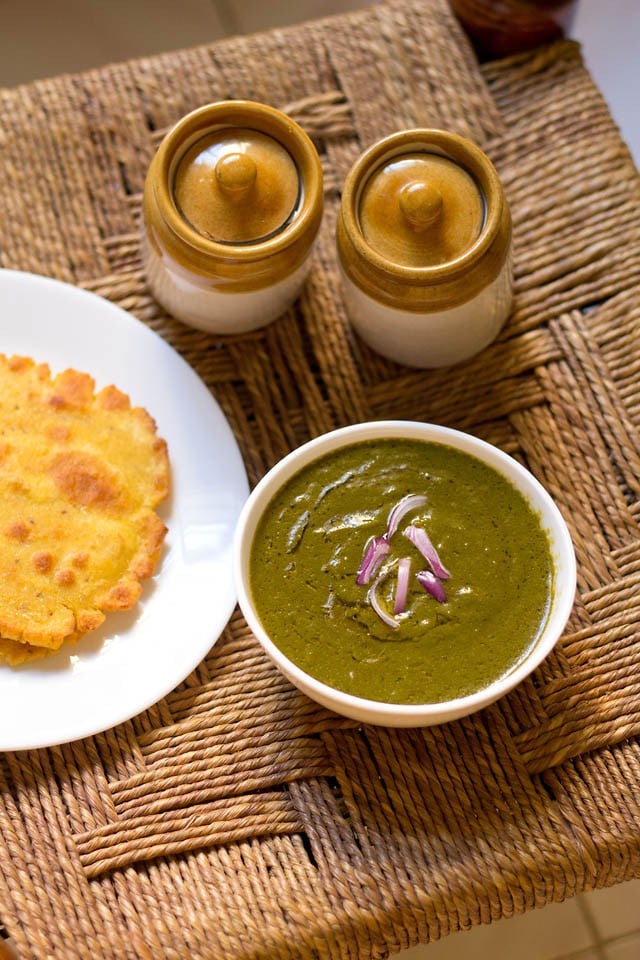
FAQs
You can just skip it, or feel free to add in more spinach. Please note that bathua is also known as chenopodium album, melde, lamb’s quarters, goosefoot or fat-hen.
White radish root – also known as daikon – is a delicious vegetable. If you are unable to procure it, I suggest substituting white turnips or regular red radishes instead.
Maize flour – which is known as fine cornmeal in the US – can be substituted with besan (gram flour), chickpea flour, or rice flour if you prefer. The purpose of this ingredient is to act as a thickener, as well as to tone down the bitterness of the mustard greens.
If your sarson greens are bitter, I suggest that you reduce the amount that you use and increase the amount of spinach proportionally.
Alternatively, you can do as my mother-in-law used to and get rid of the cooking water from the greens; I don’t prefer to do this because you lose out on some of the nutrients, but it should decrease the amount of bitterness you taste.
I suggest you use it within 4 to 5 days. You can also freeze any leftovers for up to 1 month. To serve from frozen, defrost, reheat and then add the tempering.
Yes! So long as you keep the proportions the same, you can either halve the recipe or double/triple it as needed.
More Punjabi Delicacies!
Paneer Recipes
Palak Recipes (Spinach Recipes)
Okra Recipes
Vegetable Recipes
Please be sure to rate the recipe in the recipe card or leave a comment below if you have made it. For more vegetarian inspirations, Sign Up for my emails or follow me on Instagram, Youtube, Facebook, Pinterest or Twitter.
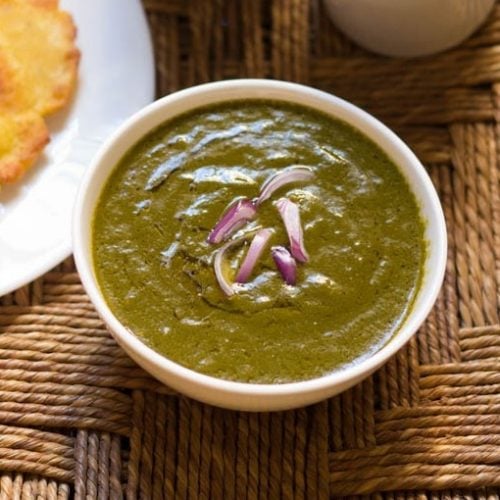
Sarson ka Saag Recipe (Authentic Punjabi Style)
Ingredients
For sarson ka saag
- 1 bunch mustard greens (sarson)
- ½ bunch bathua leaves (chenopodium/goosefoot/melde)
- ½ bunch spinach leaves (palak)
- 1 cup chopped radish leaves – use tender leaves, (mooli ke patte)
- 3 to 4 inches white radish root
- 1 cup fenugreek leaves – chopped
- 1 cup chopped onions or 2 medium sized onions
- 1.5 cups chopped tomatoes or 3 medium-sized tomatoes
- 2 inches ginger – chopped
- 2 green chilies – chopped
- 7 to 8 garlic – medium sized, chopped
- ½ teaspoon red chili powder
- 2 to 3 pinches asafoetida or ⅛ teaspoon asafoetida powder (hing)
- 2 to 3 cups water or add as required
- 2 tablespoon maize flour or fine cornmeal
- salt as required
Tempering saag for 3 servings
- ⅓ cup finely chopped onions or 1 small to medium-sized onion
- 1 to 2 tablespoons oil or ghee
- 2 cups cooked saag or as required
Instructions
Making sarson ka saag
- Firstly clean and chop all the greens. Then wash or rinse the greens very well in running water.
- In a 5 litre stovetop pressure cooker or pan add all the ingredients listed under "for sarson ka saag" except for maize flour.
- Cover the pressure cook and cook for 6 to 7 minutes or more on medium-high heat.
- If cooking in a pan, then cover and let the greens cook till tender and softened. Do check occasionally.
- Pour the greens along with the stock and maize flour in a blender. Blend till smooth.
- In another deep pan or in the same cooker, pour the pureed greens.
- Simmer for a good 25 to 30 minutes on a low heat stirring at intervals.
Tempering for sarson da saag
- In another small pan, heat oil. Use any neutral oil. You can also make the tempering with ghee if you prefer.
- Add the chopped onions and saute them till light brown on medium-low heat.
- Add the prepared saag. Stir and simmer for a couple of minutes.
- Stir ocaasionally when the saag is simmering.
Serving Suggestions
- Serve sarson ka saag hot with a side of some chopped onions, whole green chilies or mango pickle. Top the saag with a dollop of white butter and serve with Makki di Roti. Also serve a few jaggery cubes by the side.
- For a vegan saag, omit adding white butter or use vegan butter.
Storage
- Store the pureed and simmered saag in an airtight container for 4 to 5 days in the refrigerarot. You can also freeze it for a month.
- When ready to serve, remove the quantity you need from the refrigerator and temper it with the required amout of oil and onions.
Notes
Nutrition Info (Approximate Values)
This Sarson ka Saag recipe post from the archives, first published on December 2012 has been republished and updated on November 2022.
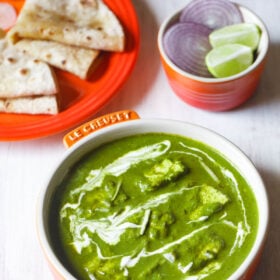

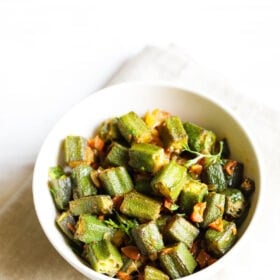
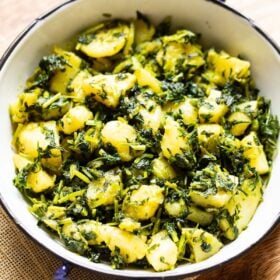
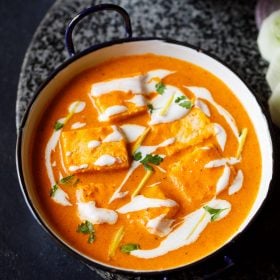
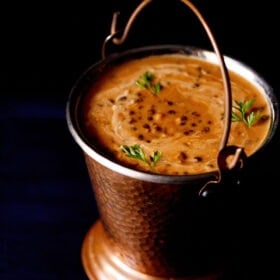
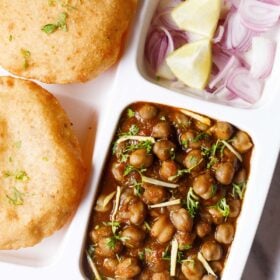








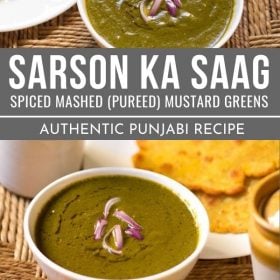
I have been making this recipe for almost a year and my whole family goes crazy for it! I added more garlic and ginger for extra zing and cheated by adding more butter and paneer before serving. Thank you so much!
Thanks for sharing the feedback and the variations you have made. Nice to know.
Thank you for this. I got all ingredients except bathua. But I shall try and follow your directions.
Thank you 🙏🏻
Welcome!
Its delicious 😋
Thanks.
Pressure cooking will destroy all the good nutrients of the greens. Can it be made by blanching and blending the greens just like we do for palak paneer?
The mustard leaves and stems need to cook very well. Only blanching can give a raw taste. So instead of pressure cooking, I would suggest to cook the greens and stems in a pan or pot till they are tender.
I like your receipe. First time I made Sarso the saag was very yummy.
God bless you.
thanks for the feedback and kind wishes. happy cooking.
I get bathua here in US. Try lotte plaza.
With your recipe nothing is impossible to make. Thank you for being there for us.
hugs pooja and felt good reading your comment. thanks a lot.
You are a star!! anything that I cook in veg you are my ‘go to’ for it. Thank you for the extensive range and hats off to you for it!!
thank you. glad that the veg recipes are working out good. welcome and happy cooking.
Tried the recipe and it was really good. Thanks for posting it.
thanks and welcome radha.
In US we don’t get bathua. What can is put in place of bathua?
anu, just skip bathua.
Dear Dassana !!
I tried out this recipe … was a huge success !!
Thanks for sharing your awesome recipe .,, !!
Appreciate your food ethos and your thoughts that you put forth on each of your recipie blogs …. simple style of cooking , fuss free , easily available ingredients ,… right from the kitchen cupboard , your originality , suggestions for possible omissions , replacing with substitutes , clarity with pics and explanations , step by step etc… a great teacher !!
Thanks and regards
Varsha Chand
Thank you much Varsha. So glad to read your comment. Happy cooking.
Hello, Can I use mantra corn daliya instead of maize flour? Are the same thing?
Thank you
they are not the same thing. maize flour is makki ka atta whereas corn daliya is coarsely ground corn. but you can grind some daliya in a small mixer and grinder and add the ground flour to the saag.
Too Good
Thanks Madhu
Dear Dassana, thanks for sharing the amazing recipes!!

Welcome Purva
Awesome…
Thankyou
Welcome Indu
Hi Dasanna,
I love all your recipes. Do you have any ideas for cooking veggies like broccoli, kale, Swiss chard using Indian spices?
Thanks
thanks deepa. i have only cooked kale and broccoli. never used swiss chard as we do not get it here. kale can be used similar to spinach or drumstick leaves in recipes. so any recipe that you make with spinach or drumstick leaves, you can make the same with kale. for broccoli use it like cauliflower. i always blanch broccoli and use. you can make patties, stir fry, parathas, sabzis easily with broccoli.
Dear Dassana, Made this recipe today and it turned out delicious. I had been wanting to make it since such a long time. I don’t know how I forgot to check your site. It turned out so yum I will be making this again and again.
Thanks Lopamudra. Glad to know that you liked the sarson ka saag. its taste awesome with makki di roti and specially when you eat it in winters.
Hi
I have been following your blog for some time now and have used a few recipes. They are all so appropriately written and explained! Love the details 🙂
Quick question – can I make this saag without spinach and bathua?
thanks shalu. you can make the saag without spinach and bathua.
Can you find Chenopodium in America (I live in Tennessee). if so what should I look for in the supermarket or Farmer’s market. If it is not available what is a good substitute?
Surjit, no idea about USA. however bathua leaves are also known as chenopodium album, melde, lamb’s quarters, goosefoot or fat-hen.
Thank u so much dear for sharing this finger licking recipe….. I could not believe that I have made this n that’s also in my first attempt…. My family loved it….Always follow ur site… The way u explain the cooking method is just great…. Thnx again
Welcome Archie. Glad to know that you all liked saag recipe.
great step b step detailed guide. thanks a ton for this.
thanks vivek.
Love the detailed instructions. I just moved to the US and have just started cooking for the first time in 30 years. Your blog is a big help and thank you for that. I have a couple of quick questions regarding this recipe:
1. Can I just use spinach instead of the other greens you have mentioned? It’s hard to find most of the mentioned greens here.
2. Is there a substitute for maize flour I can use? Like besan or maida or wheat flour? I don’t use maize flour for anything else so I don’t know I should buy entire bag (only 1 kg bags available) of maize flour.
thanks chan.
1. if you use spinach only, then it will be palak saag. you can use spinach only, but then scale down the recipe to half or one fourth.
2. you can use besan or rice flour. i have used besan and rice flour in thickening gravies. never tried whole wheat flour. if you want, you can even lightly roast the besan and then add.
Just ate saag today and we are walking around in the house like morons because everyone over ate and can’t go to bed with a tummy that’s ready to burst??and it’s almost midnight.Thanks a ton dear,god bless u.
i can relate to you simone. thanks for your kind wishes. you can have a generous pinch of asafoetida (hing) dissolved in some warm water or some fennel seeds or cumin seeds, to be chewed directly.
Hi dear,
Thank u for all the amazing recipes.I always follow your recipes whenever I want to cook an Indian dish that I have not tried ever before and everyone simply loves them.??I really appreciate all the hard work u put in and make sure that u cover even the minutest details.Thank u for making me into a master chef?.
thanks again simone. felt good reading your comment. happy cooking master chef 🙂
Hi dear…
This saag was awesome… I follow this site always. These recipes are superb… Great going good luck and thanks a lot for sharing.
thank surbhi for the positive review on saag. welcome and happy cooking.
Hello there! Thank you so much for this recipe. 🙂
I made sarson ka saag using your recipe, yesterday, and it turned out delicious!
thanks for the feedback. good to know.
Awesome recipe. First time tried it and turned out to be great. Avid follower of your blog. Love the detailing, accompanying pictures and simple recipes. Keep it up pls!
glad you liked the sarson ka saag 🙂 thankyou for your kind and positive words.
Amazing recipe
Thanks
thankyou rajesh 🙂
thanks for sharing the wonderful recipe. I make this every winter, i suggest try adding sua (dil leaves) to it in the half proportion of spinach. It gives a wonderful flavour to saag. I learned this from my grandmother. Thought of sharing with you.
Regards
Seema
thankyou seema sharing your tips with us and you are welcome 🙂
This was so good, my mom actually cried and said she was proud of me. Although I am of Indian decent, I barely ever cooked Indian food until I found your blog. My grandma said thank god for the internet that my granddaughter is finally learning to cook sabzi. – Ha ha, Thanks! Love this recipe and your website.
welcome sabrina. thats so nice to hear. glad to read the response of your mother and grand ma. do try some more recipes.
Hi I have been cooking punjabi food for the past 18 years including sarson ka saag but I really liked your receipe it is similar to my receipe but with a twist you added the seasoning and tadka material while boiling that is sure to enhance the taste
thanks shamli for your positive feedback. tadka added to any dish towards the end enhances the taste. felt good to read a positive comment from a seasoned punjabi cook.
Awesome Dish.
thanks kriya
Hi… From the second i saw this recipe i like to try it… I searched in all stores and got all the greens except bathua leaves, can this be done without that or its compulsory?
meena, you can skip bathua.
Hi,,,, At-last i tried this and came out very very awesome, my husband loved it.
Thank you for the recipe
welcome Meena. glad to know this.
I have always heard about this recipe, but never tried it. I want to prepare this recipe.
But can I make this recipe by using only sarson leaves & palak.
If yes then can you give me the measurement by cups (i.e sarson leaves & palak leaves chopped & measured in cups)
shalini, for 2 cups of mustard use one cup of spinach. the ratio is 2:1 for mustard and spinach respectively. you can increase or decrease the ratio proportionately.
Thanks for the awesome recipe. This dish is sooo easy to make in a pressure cooker. And it came out yummy. I received compliments from all. Thanks for your step by step instructions which ensured that I did not goof up anywhere!
Thanks for sharing positive feedback on Saag. Glad to know that it came out well.
thanks for the recipe. You are definitely correct in that it takes a long time to prepare this dish. I enjoyed making it and eating it with a lot of help from my husband . I followed your recipe almost to the extreme. the only difference was i cooked it in a saucepan rather than a pressure cooker – i have never used a pressure cooker. I had bought all the different bhajis yesterday when i went shopping without even thinking what i was going to do with them. i ate the saag with makki ki rotis – your recipe too. will definitely look out for more delicious recipes from you.
welcome mina. glad to know this. you can make in a sauce pan also. i use pressure cooker as it is faster to cook and save gas. makki do roti with sarson da saag is an awesome combination.
Thanks dassana for all the amazing recipes.
welcome nisha
Being a novice, i had never thought i’d be able to cook saag ever in my life…that too so yummy.
Your recipies are simply the best and so easy to follow.
Thanks for this one…it was a treat and everyone loved it.
welcome shadab. thanks for sharing positive feedback on recipes.
It was really very yummy!!!!!
tried your many recipies …. All are awesome!!!!
Please let me know the recipe for BAJRA ki Khichdi…..
thanks sweta. i will try to add bajra khichadi before winters. lets see if i can.
Best recipe, tried today and will use it forever, thanks…
welcome meenakshi
Thanks for the recipe.What can I use instead of maize flour?
welcome sanchita. you can either skip adding maize flour or add gram flour/besan.
Thank u so much Dassana for sharing such lovely recipe of sarson ka saag….this is the first ever best recipe of saag on Google…I really appreciate ur hard work of preparing and clicking pics….well done.
welcome payal. thanks for this sweet as well as positive feedback.
I like your recipe. I did without onion and garlic it was good. I am non eater of onion and garlic. If you find any recipe without onion and garlic please let me know
thanks kamala for sharing your positive feedback. i have shared many no onion no garlic recipes.
VERY TASTY MOUTH WATERING .
thanks rashida
I looked various websites but your process, method n pics made it really interesting.
Thanks
welcome jyotirmoy
Interested in cooking.
hi iam a south indian recently settled in delhi. i always wanted to make this saag recipe but reluctant because i. keep up the good work. dont know the proper method. then i saw your post,tried it. wow it came out excellent.thanks for the step by step recipe
thanks vimala for the feedback.
U can make it directly by steaming sarsoon tomatoes green chillies then tempering mustard oil garlic making it dry it also tastes good
thanks anchal for the suggestion.
Your recipe is too good & easy
thanks pinky
Very nice and clearly explained receipy.
thanks rohit.
Hi Dassana Thanks for the lovely recipe. the pics look really good.
This recipe looks very delicious and authentic
Just wanted to ask can i boil the greens and vegies and keep it in fridge for a couple of days and then grind and cook it on the day we want to eat? Also one of my north indian friend once suggested to add brocolli as well in the vegies? what do u think?
Thanks heaps for always replying. Really appreciate it!
usually we grind and keep in the fridge. i am not sure how the boiled veggies will be and how long they will stay good. i don’t add broccoli. but you can add. it is more like a variation to a recipe.
Thanks Dassana!
Thanks for the beautiful recipe!!!
welcome gunjan
We enjoy Indian food and I often go to your website whe looking for a special recipe. Your instructions are clear and we have never been disappointed with the results.
I have a question you may be able to answer. I have tried to find my answer by cruising the internet with no results.
I sent my husband out to our local Middle Eastern food for pita bread. He came home with this lovely, paper thin bread called sag. The sheets of bread were rectangles about 12inches by 8inches folded as one would fold a sheet of paper.
It may not be Indian, but I can find no information on how to use it. Any suggestions? Thank you.
thanks evelyn. the bread is actually saj. it is a middle eastern bread. they are cooked like the way we cook roomali roti (thin handkerchief like round breads) in india. if you type saj bread on google, you will get its recipe.
Lovely Post…wonderful pics…
Sari umar sanu Sarson da saag yad rahega.
Mai Kiran Kapoor de nal khaya si.
I am fond of Sarson da saag since I had it with our relative as mentioned above, now we too make the same at home, we live in Vadodara Gujarat here mustard seeds are of bitter “Rai” kindly tell me if to drain out the water after boiling the sarson leaves as water is bitter? Please tell us or give a tip on this as we drain out the water after boiling the Sarso,palak& bhathu leaves are doing correct?
virendra, when i make saron ka saag then the mustard leaves are not bitter here. so i checked with my mil. she says her mil used to remove the water as the sarson used to be bitter. but then you lose nutrients. my mil suggest to reduce the quantity of sarson and increase the quantity of palak and bathua and with this method she does not throw the water and sarson ka saag is not bitter.
Hi Dassana,
I first came upon your website searching for the saag recipe. Now any recipes i need i first search yours. In fact your website is permanently open on my laptop!! The saag came out really well and was very useful for me as a long term option 🙂 (what with cooking with a 7 month baby in my hands). How long can the saag be safe for storage in the fridge?
Thanks,
Lavanya.
hi lavanya
thanks for this positive feedback.
you can safely use saag for 3-4 days, if kept in fridge.
after 4th day, just taste the saag whether it is good or not.
i have heard many people freeze the saag and use it for a longer period… but personally i have never tried this method.
last time, my saag which was kept in the fridge got slightly spoiled on 5th or 6th day.
i hope it helps.
dassana
I was looking for authentic punjabi Sarson ka saag and I got it. Today I made Sarson ka Saag. It’s become yummy and tasty. My mother and sisters also like this very much. Thank you Dassana Amit. For tempering I used dry red chilly also.
welcome geeta and thanks for this positive feedback on saag recipe.
Fantastic instructions. …
thanks sirisha
She is awesome. I failed in making modaks following her recipe during ganesh chaturthi. but that was my fault. whenever i need a veg recipe i look up her blog. so thank you very much. i would like to know the use of traditional cookware in making food.i mean the better way of storing foods to cooking them in vessels pots etc..
thanks uma. i don’t know how i missed your comment for so long. there a lot of traditional cookwares available in south india like kerala, karanataka etc. though i use modern cookware, i also have clay and stone pots for cooking. again even iron kadhai is good as when you cook in it, some iron gets into the food. for storing after the bharni used for pickles, salt etc, next best is glass. steel jars are also good for storing.
I love your website!! your presentation n photographs are so good, a newbie like me can feel the clarity and the possibility of all that effort coming out right.
thanks simran. its nice to know that the website is helpful to you.
Hi, what can I use instead of maize flour? is it optional ?
instead of maize flour you can also use gram flour or besan. maize flour helps in thickening the saag and also tones down the bitter pungent taste of the mustard leaves. its better to add the flour.
OMG this was delicious! I found this recipe this morning and made it in about less than two hours. Came out really yummy. I did not have all the greens still the saag was superb!
Thanks for the recipe.
thanks for the feedback.
Looks great..
I use mustard leaves, spinach, bathu, red chillies and spring onion under the list of saag…
and tardka lega with plenty of chopped garlic, ginger, onion and bit of mustard seeds. It taste superb.
thanks for the suggestions seena.
Dassana
now where did you manage to get the above two greens I mean the mustard , the bathua and the garlic chives is the second one same what is usually refered to in marathi as chandan batua. nice pictures again
Your instructions for cooking this saag dish are very easy to follow…………I am going to make it for myself and my sisters, as since our mother passed away, non of us have an idea as to how to replicate our dear mums dish!!! Thank-you and thank-you again!!!
hi chandra, your comment brought tears to my eyes. i feel so touched & humbled as well. saag is easy to make, but a lengthy process. you will be able to cook a delicious saag for yourself and your sisters. hugs 🙂
Lovely step by step tutorial Dassana! Very helpful for south indians like me 🙂
Here in Karnataka we make a curry similar to dish called ‘Massoppu’ which is variety of greens cooked with lentils, mashed and seasoned. It’s so lite and flavorful.
Thanks for this… I dont get mustard or bathua…can i try it with methi palak and mooli ? how will that be ?
you can make saag with methi, palak and mooli. just keep the proportion of methi and mooli less in the saag. methi can make the saag bitter. for 1 bunch of spinach, i would suggest 1 cup of methi leaves and a small piece of radish along with 1/2 cup of chopped radish leaves.
In most American restaurants, the classic dish is saag paneer–and as a result I never thought I liked saag. I just don’t care for it with paneer. I now know it is one of my favorites! Usually with poultry or meat, but I like chickpeas ok as well. And I love mustard greens. Looks fantastic.
I wish I could find all those leafy vegetables over here…Can you give me substitute for bathua leaves and sarson leaves…..very tempting to make it 🙂
there is no substitute for bathua or sarson leaves. but saag can also be made from spinach and methi. so you can try making this way.
super… lovely step by step for the recipe… i hve never tried my hands at this… must surely make it some day… will let u know when i do make it.. lovely!
sure and thanks for those words. do make the saag with makki di roti. it is an awesome combination and one that should be had at least once.
Healthy and delicious saag..Love it..Everytime I visit here I find something new…Never tried my hands on bathua leaves..Totally new to me..
Yummy and inviting !!
Loving it to the core…looks delicious n yummmm